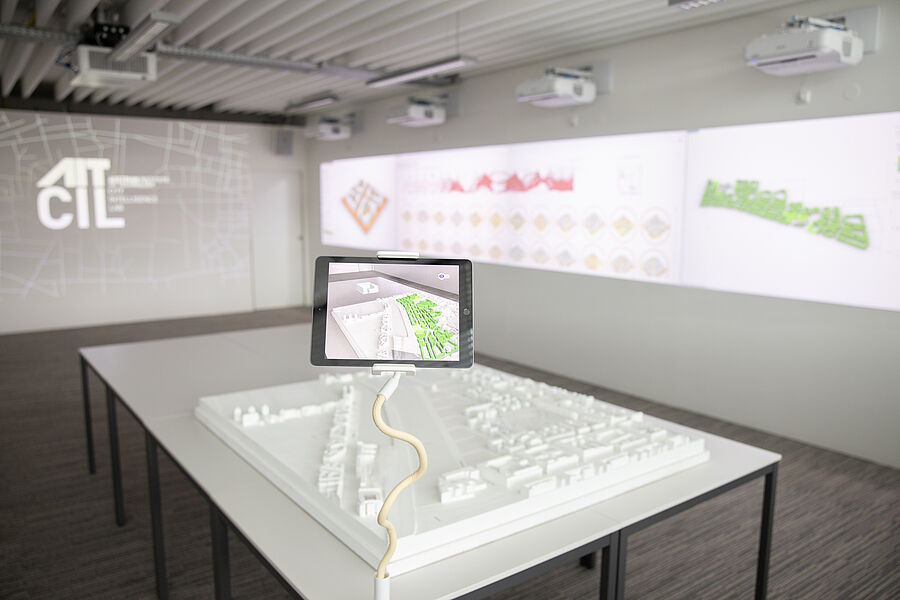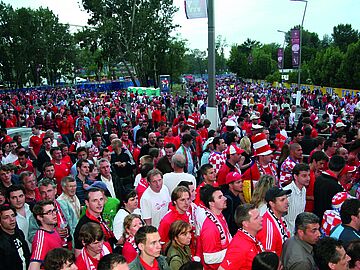Future-proof mobility concepts for cities and regions: strengthening resilience through innovative planning
For a resilient city, the mobility system is a crucial factor. Therefore, well-founded mobility concepts for cities and regions, based on robust methods for predicting and assessing mobility behavior—including rebound effects and accurate demand forecasts—are of vital importance.
We develop methods that link urban development and mobility strategies by employing novel planning tools at different scales (from micro to macroscopic and short to long term). This makes it possible to examine the impact of measures in a targeted and stakeholder-oriented way (e.g., for urban planners, transport operators, and political decision-makers). A key concern in this context is the design of policies that enhance a city's adaptability to developments such as climate change, urbanization, and major transformations in the transport system (automation, Mobility as a Service/MaaS).
We address this need by developing integrated approaches for modeling and simulating various modes of mobility, which allow the resilience of cities to be assessed across different scenarios. Based on these results, policy measures are derived to prepare cities and regions for climate change as well as social and economic shifts, and to help develop emergency, evacuation, and recovery planning.
Mobility concepts for cities and regions: our focus
AIT focuses its work on the following areas:
- Modeling of mobility demand in response to both hard and soft traffic management measures, and the resulting supply management.
- Forecasting the impacts of new mobility concepts such as autonomous vehicles or Urban Air Mobility (UAM).
- Methods for identifying and evaluating potentials for effective traffic planning (e.g., cost-benefit analyses, rebound/backfire effects relevant to climate targets, and land use accounting).
- Analysis of mobility patterns considering social milieus, and identification of clusters of behavioral change in response to transformation.
- Assessment of the potential for change within the transport system in both short-term developments (e.g., pricing strategies, parking management, new public transport, sharing systems, road construction) and medium- to long-term trends (e.g., Mobility as a Service—MaaS, and automated vehicles).
- Backcasting potential pathways to achieve desired climate and mobility goals.
- Simulation of incidents and the effects of countermeasures (e.g., risk analysis, scenario investigation, and recommendations for action) for emergency planning.
- Co-creation through a hybrid digital framework.
Data-driven mobility concepts for cities and regions: innovative modeling for a connected and sustainable future of transportation
We develop data-driven approaches for modeling, analysis, and decision support in response to changes in the mobility system, with a strong focus on people’s needs. Our emphasis is on predicting movement patterns within multimodal systems in order to manage mobility as an integrated whole, ensure seamless travel chains, and replace the previously common loose coupling of different mobility services.
To achieve this, we rely on innovative modeling approaches that can be directly applied by various stakeholders to reduce uncertainty in investment and policy decisions related to land use and transport planning. We investigate the interaction between different mobility modes (e.g., pedestrians and autonomous vehicles) and incorporate these dynamics into new simulation and planning tools.
Modelling, Simulation and Evaluation of innovative transportation solutions
- Simulations for predicting and analyzing complex pedestrian flows
- Modeling and simulation of mobility measures in relation to human decision-making patterns
- Modeling and Evaluation of Mobility Concepts
Modeling and Evaluation of Mobility Concepts
We study and evaluate the introduction of new mobility concepts—from micromobility and Mobility as a Service (MaaS) to autonomous vehicles and Urban Air Mobility (UAM)—into transport systems. The goal is to identify potential improvements in transport system capacity, congestion reduction, and increased efficiency, safety, and comfort within the system. Our assessments are based on innovative modeling approaches that can be directly used by various stakeholders to reduce uncertainty in investment and policy decisions related to land use and transport planning.
Our Offer Includes:
- Flexible mobility simulation environments using mesoscopic, agent-based transport modeling tools and microscopic transport simulations
- Modeling and simulation of mobility measures in connection with human decision-making patterns and behaviors, using statistical modeling and deep learning methods
- Investigation and modeling of human responses to environmental influences, new technologies, changes in transport infrastructure, or traffic safety issues across the entire transport system
- Model calibration and validation using extensive mobility behavior datasets derived from experiments, real-world measurements, and mobility surveys
- Modeling of new mobility concepts such as autonomous vehicles, MaaS, and UAM
Simulations for predicting and analyzing complex pedestrian flows
Optimizing and analyzing the flow of people in urban areas is a major challenge. Based on the latest research and state-of-the-art technologies, AIT offers customized, scalable solutions for simulation, analysis and planning.
The range of applications for SIMULATE is as diverse as the urban challenges themselves. This includes safety-related issues such as the evacuation of large buildings or major events, business-related challenges like optimizing customer flows in shopping centers, or new approaches to designing buses, trains, and stations. The goal is cost savings by ensuring optimal mobility, efficiency, comfort, and safety.
The methods we use within the SIMULATE framework are scientifically recognized and the result of our years of research in the field of crowd dynamics.
Another important component of the models and methods is comprehensive data from a variety of real-world pedestrian flow analyses.
SIMULATE simulates visitor flows, identifies flow rates, and highlights main routes and potential bottlenecks.
Scenarios for structural and organizational measures can be analyzed both in movement models and virtual environments. Results are presented using 2D and 3D animations as well as various evaluation methods.
- Well-founded decisions and avoidance of bad investments for existing and planned facilities
- Flexible scenario techniques enable testing of alternative courses of action
- Efficient and cost-effective execution, for example through the use of existing CAD plans
- Future-proof, for example through compatibility with the BIM standard (Building Information Modelling)
Modeling and simulating mobility measures in connection with human decision-making patterns
We assess human perception of urban mobility systems using various data sources and work on methods to improve urban environments (e.g., regarding walkability) and on the development of efficient strategies for behavior change (e.g., incentives during unforeseen events in the mobility system). Our research supports the development of responsive mobility systems that can adapt to individual and collective needs of their users. In order to properly assess these responses, we examine mobility behavior based on combinations of stated and revealed preferences (SP and RP), which are collected using specialized survey methods, thereby reducing the hypothetical bias of pure SP data. Another focus is the provision of personalized routing services based on user classification, enabling individual adaptation of services.
Technologies to support interaction between the population and decision-makers in the political decision-making process are becoming increasingly important. Therefore, we further develop planning tools that were previously used only by urban planning experts to create environments for co-creation processes and to enable impact assessments on various levels. A particular research focus is on virtual and augmented reality technologies to improve participatory planning processes and to give stakeholders the opportunity to experience and influence design decisions in public space on a highly immersive level already in early planning stages. For this reason, we develop innovative interaction approaches for such systems to provide the necessary flexibility to ensure usability for both experts and citizens.
Approaches and methods we use:
- Methodical collection of reliable data on changing traffic environments and for assessing the impact of planned traffic measures on the behavior of individuals from affected target groups
- Investigation of human movement behavior in the context of different transport modes (e.g., pedestrians, bicycles, cars, public transportation)
- Virtual reality technologies to evaluate infrastructure designs and the resulting user reactions through analysis of movements, gaze directions, and other relevant behavioral characteristics
- Participatory planning methods in combination with virtual and augmented reality technologies
- Computer-based crowd management systems for the automatic optimization of individual pedestrian flows up to dense crowds
- Analysis of heterogeneous sensor data (e.g., WiFi tracking) to model demand and movement patterns
- Development and evaluation of persuasive strategies for changing mobility behavior
- Incorporation of human factors into decision modeling






